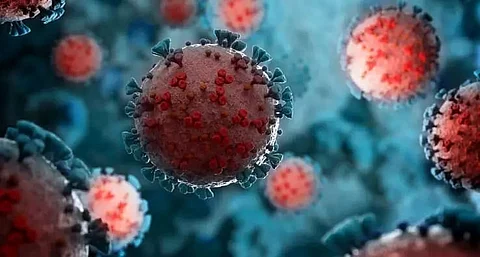
- Home
- Live Blog
- Breaking News
- Top Headlines
- Cities
- NE News
- Sentinel Media
- Sports
- Education
- Jobs

KOLKATA: He prefers to be called 'The Seeker'. To protect his anonymity, he communicates through Twitter handle '@TheSeeker268', with the logo of a little-known tribal art of Bankura or Birbhum but this West Bengal man, who is in his late 20s and probably from Kolkata, has been responsible for challenging the conventional theory that SARS-Cov-2 was a spillover from animals and to show how it was a lab leak from Wuhan Institute of Virology (WIV).
A member of DRASTIC (Decentralized Radical Autonomous Search Team Investigating COVID-19), 'The Seeker' is neither a scientist nor a scientific researcher but this former teacher of science is an avid internet data miner who managed to learn the weird but painstaking technique of searching the back alleys of the web, far beyond the well-lit places patrolled by Google, and there, stumbled upon some obscure documents that perhaps could become the biggest revelations of the 21st century.
In a series of mails to IANS, 'The Seeker' explained what prompted him to look beyond the conventional Chinese 'Animal-to-Human' theory that the world had started to believe.
It was in early 2020 when the 'The Seeker' posted one paper on Canadian Yuri Deigin's theory on Reddit, which promptly suspended his account permanently. This aroused his curiosity and led to delve deep into the investigation.
"It was a Medium post by the Canadian longevity entrepreneur Yuri Deigin that discussed RaTG13, a virus Shi Zhengli had revealed to the world in a February 3 paper in the journal Nature. In that paper, Shi presented the first extensive analysis of SARS-CoV-2, which had seemed to come from nowhere - the virus was unlike any that had been seen before, including the first SARS, which had killed 774 people from 2002 to 2004. In her paper, however, Shi also introduced RaTG13, a virus that is similar in genetic makeup to SARS-CoV-2 but never mentioned where RaTG13 had come from.
"He (Deigin) wondered if SARS-CoV-2 might have emerged through some genetic mixing and matching from a lab working with RaTG13 or related viruses. His post was cogent and comprehensive and I posted the theory on Reddit after which my account was permanently suspended. This aroused my suspicion further," 'The Seeker' wrote.
After a lot of trial and error, 'The Seeker' stumbled upon exactly what he was looking for: a master's thesis written by a Chinese doctor. The document contained an account of six cases of "severe pneumonia caused by unknown viruses" in workers who had been cleaning an abandoned copper mine in Yunnan, China, in 2012. The patients' symptoms seemed eerily similar to those of Covid-19. Three of the patients, it said, died from the mystery illness.
"It was a 60-page master's thesis in 2013 titled 'The Analysis of 6 Patients with Severe Pneumonia Caused by Unknown Viruses'. In exhaustive detail, it described the conditions and step-by-step treatment of the miners. It named the suspected culprit: 'Caused by SARS-like (coronavirus) from the Chinese horseshoe bat or other bats," he wrote.
"Finding it, at that moment, felt big... like a homicide detective solving a cold case," 'The Seeker', who presently works with diverse elements like architecture, painting, and filmmaking, he wrote.
'The Seeker' dropped the link, without fanfare, on May 18, 2020, then followed up with a second thesis from a PhD student at the Chinese CDC, confirming much of the information in the first. Four of the miners had tested positive for antibodies from a SARS-like infection. And the WIV had been looped in to test samples from them all.
Shortly after 'The Seeker' posted the theses, China changed the access controls on CNKI so no one could do such a search again.
The Yunnan mine and its resident bats, 'The Seeker' knew, had been sampled by researchers at the Wuhan Institute of Virology. He'd uncovered a missing puzzle piece: an association between the closest known relative of the coronavirus and research conducted at the institute in Wuhan, China.
Though a majority of scientists and experts agree that the coronavirus emerged after jumping from a wild animal to humans somewhere in or around Wuhan, where the first cases appeared in 2019 but an alternative theory posits that the pandemic began after SARS-CoV-2 leaked from a laboratory in Wuhan, potentially the Wuhan Institute of Virology, which needs further investigation.
Though there are lots of grey areas regarding the origin of the virus but thanks to DRASTIC and particularly 'The Seeker', from whom it is now known that the Wuhan Institute of Virology had an extensive collection of coronaviruses gathered over many years of foraging in the bat caves, and that many of them – including the closest known relative to the pandemic virus, SARS-CoV-2 – came from a mineshaft where three men died from a suspected SARS-like disease in 2012.
It is now known that the WIV was actively working with these viruses, using inadequate safety protocols, in ways that could have triggered the pandemic, and that the lab and Chinese authorities have gone to great lengths to conceal these activities.
Asked whether he faced any pressure after these things came to light, 'The Seeker' only said: "I want you to focus on the facts, not me. It's an article. Write about my findings." (IANS)
Also Read: What makes SARS-COV-2 a threat?